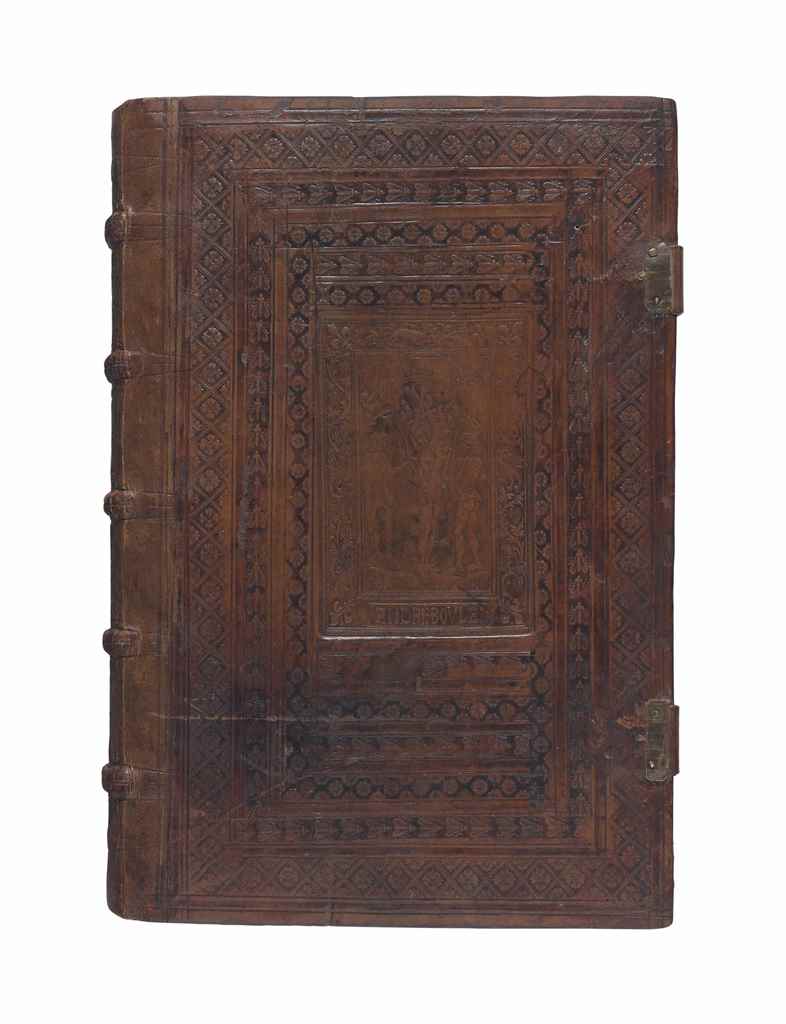SENECA, Lucius Annaeus (the younger, 4 B.C./1 A.D.-65 A.D.). Epistolae ad Lucilium. -pseudo-Seneca. Epistolae ad Paulum apostolum et Pauli ad Senecam . [Strassburg: R-Press type 1 (Johann Mentelin and/or Adolf Rusch), ca. 1474-75]. Chancery 2° (290 x 210mm). Collation: [1 8 2 10 3 10 (7+1) 4-5 10 6 6 7 8 8-9 10 10 1 2 11-12 10 13-14 6 15-16 10 17-18 6 19-21 10 22 6 (2+1) 23 6 24 10 ] (1/1 blank, 1/2 text, 24/6v letters to and from St. Paul, 24/9r epitaph for Seneca, 24/9v-10 blank). 211 (of 212, without final blank) leaves. 35 lines. Type 1:103R. 2-, 3-, and 7-line initial spaces, some with guide-letters. (Small marginal repairs in 5/2,3,6, 7/2, 22/5, tiny wormholes in quires 23-24 filled, light stain in inner margin of 24/1.) Gold-tooled blue straight-grained morocco, panelled sides in gilt and blind with Botfield arms added at centre, spine tooled in compartments, gilt turn-ins, mustard endpapers with blindstamped edge, vellum flyleaves, gilt edges, pink silk ribbon marker, by François Bozerian (Bozerian jeune), with his stamp at foot of spine. Provenance : Unrubricated; Beriah Botfield acquired, probably in 1830, from Payne & Foss for #21.0.0 (P. & F. Acquisitions, p.82), price pencilled on flyleaf. Possibly the FIRST EDITION. A spate of four editions of Seneca's Epistolae appeared in 1475, three dated that year (one at Paris which contained only letters 1-88, one at Rome by Sweynheym and Pannartz, and one at Naples added to the Opera philosophica ) and this undated Strassburg edition printed in type used from 1473 to 1475. Thus, it may precede the dated editions. The R-printer, so called because of the unusual R in the fount, is generally identified as Adolf Rusch, son-in-law of Johann Mentelin, the first printer at Strassburg. Type 2 of this press was used in the printing of an anonymous edition of Vincent of Beauvais Speculum doctrinale (Klebs 1037.1), for which Mentelin and Rusch are known to have been responsible from contemporary documentary evidence. This type 1 was previously considered the first roman type, but since its earliest date of appearance has been revised to 1473, other roman founts in Italy and Germany take precedence. These letters, the most popular of Seneca's works, are addressed to a real person, Gaius Lucilius Iunior, but they are a fictional correspondence, a form perhaps influenced by Cicero's letters. They deal with philosophical questions, stressing the importance of the study of philosophy and expounding the Stoic school to the Epicurean Lucilius. Because Seneca often uses examples of daily life to illustrate his points, the letters also provide glimpses into contemporary Roman life. Included in this collection is the apocryphal correspondence of Seneca with St. Paul; it frequently accompanied Seneca's genuine letters from the early Middle Ages. HC *14597; BMC I, 62 (IB. 650-1); Goff S-379; CIBN S-189; Flodr, Seneca 11
SENECA, Lucius Annaeus (the younger, 4 B.C./1 A.D.-65 A.D.). Epistolae ad Lucilium. -pseudo-Seneca. Epistolae ad Paulum apostolum et Pauli ad Senecam . [Strassburg: R-Press type 1 (Johann Mentelin and/or Adolf Rusch), ca. 1474-75]. Chancery 2° (290 x 210mm). Collation: [1 8 2 10 3 10 (7+1) 4-5 10 6 6 7 8 8-9 10 10 1 2 11-12 10 13-14 6 15-16 10 17-18 6 19-21 10 22 6 (2+1) 23 6 24 10 ] (1/1 blank, 1/2 text, 24/6v letters to and from St. Paul, 24/9r epitaph for Seneca, 24/9v-10 blank). 211 (of 212, without final blank) leaves. 35 lines. Type 1:103R. 2-, 3-, and 7-line initial spaces, some with guide-letters. (Small marginal repairs in 5/2,3,6, 7/2, 22/5, tiny wormholes in quires 23-24 filled, light stain in inner margin of 24/1.) Gold-tooled blue straight-grained morocco, panelled sides in gilt and blind with Botfield arms added at centre, spine tooled in compartments, gilt turn-ins, mustard endpapers with blindstamped edge, vellum flyleaves, gilt edges, pink silk ribbon marker, by François Bozerian (Bozerian jeune), with his stamp at foot of spine. Provenance : Unrubricated; Beriah Botfield acquired, probably in 1830, from Payne & Foss for #21.0.0 (P. & F. Acquisitions, p.82), price pencilled on flyleaf. Possibly the FIRST EDITION. A spate of four editions of Seneca's Epistolae appeared in 1475, three dated that year (one at Paris which contained only letters 1-88, one at Rome by Sweynheym and Pannartz, and one at Naples added to the Opera philosophica ) and this undated Strassburg edition printed in type used from 1473 to 1475. Thus, it may precede the dated editions. The R-printer, so called because of the unusual R in the fount, is generally identified as Adolf Rusch, son-in-law of Johann Mentelin, the first printer at Strassburg. Type 2 of this press was used in the printing of an anonymous edition of Vincent of Beauvais Speculum doctrinale (Klebs 1037.1), for which Mentelin and Rusch are known to have been responsible from contemporary documentary evidence. This type 1 was previously considered the first roman type, but since its earliest date of appearance has been revised to 1473, other roman founts in Italy and Germany take precedence. These letters, the most popular of Seneca's works, are addressed to a real person, Gaius Lucilius Iunior, but they are a fictional correspondence, a form perhaps influenced by Cicero's letters. They deal with philosophical questions, stressing the importance of the study of philosophy and expounding the Stoic school to the Epicurean Lucilius. Because Seneca often uses examples of daily life to illustrate his points, the letters also provide glimpses into contemporary Roman life. Included in this collection is the apocryphal correspondence of Seneca with St. Paul; it frequently accompanied Seneca's genuine letters from the early Middle Ages. HC *14597; BMC I, 62 (IB. 650-1); Goff S-379; CIBN S-189; Flodr, Seneca 11















Testen Sie LotSearch und seine Premium-Features 7 Tage - ohne Kosten!
Lassen Sie sich automatisch über neue Objekte in kommenden Auktionen benachrichtigen.
Suchauftrag anlegen